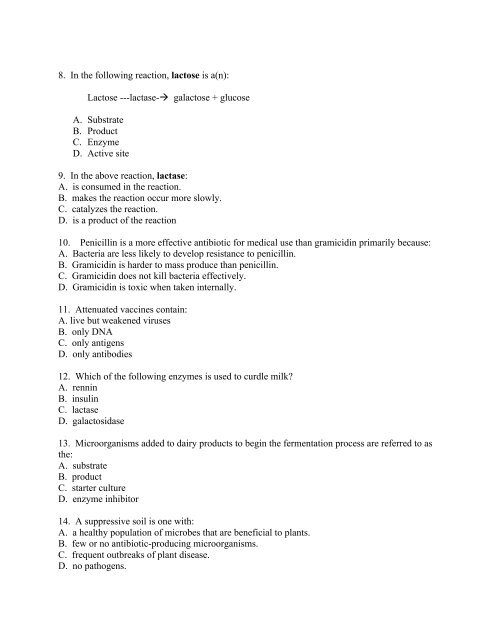Matching. Write the letter that corresponds to the best answer. ____ ...
Matching. Write the letter that corresponds to the best answer. ____ ...
Matching. Write the letter that corresponds to the best answer. ____ ...
You also want an ePaper? Increase the reach of your titles
YUMPU automatically turns print PDFs into web optimized ePapers that Google loves.
8. In <strong>the</strong> following reaction, lac<strong>to</strong>se is a(n):<br />
Lac<strong>to</strong>se ---lactase- galac<strong>to</strong>se + glucose<br />
A. Substrate<br />
B. Product<br />
C. Enzyme<br />
D. Active site<br />
9. In <strong>the</strong> above reaction, lactase:<br />
A. is consumed in <strong>the</strong> reaction.<br />
B. makes <strong>the</strong> reaction occur more slowly.<br />
C. catalyzes <strong>the</strong> reaction.<br />
D. is a product of <strong>the</strong> reaction<br />
10. Penicillin is a more effective antibiotic for medical use than gramicidin primarily because:<br />
A. Bacteria are less likely <strong>to</strong> develop resistance <strong>to</strong> penicillin.<br />
B. Gramicidin is harder <strong>to</strong> mass produce than penicillin.<br />
C. Gramicidin does not kill bacteria effectively.<br />
D. Gramicidin is <strong>to</strong>xic when taken internally.<br />
11. Attenuated vaccines contain:<br />
A. live but weakened viruses<br />
B. only DNA<br />
C. only antigens<br />
D. only antibodies<br />
12. Which of <strong>the</strong> following enzymes is used <strong>to</strong> curdle milk?<br />
A. rennin<br />
B. insulin<br />
C. lactase<br />
D. galac<strong>to</strong>sidase<br />
13. Microorganisms added <strong>to</strong> dairy products <strong>to</strong> begin <strong>the</strong> fermentation process are referred <strong>to</strong> as<br />
<strong>the</strong>:<br />
A. substrate<br />
B. product<br />
C. starter culture<br />
D. enzyme inhibi<strong>to</strong>r<br />
14. A suppressive soil is one with:<br />
A. a healthy population of microbes <strong>that</strong> are beneficial <strong>to</strong> plants.<br />
B. few or no antibiotic-producing microorganisms.<br />
C. frequent outbreaks of plant disease.<br />
D. no pathogens.

















